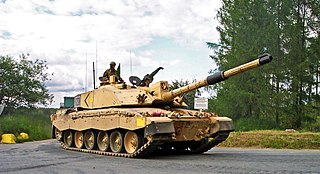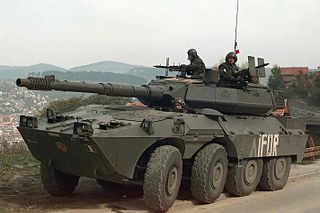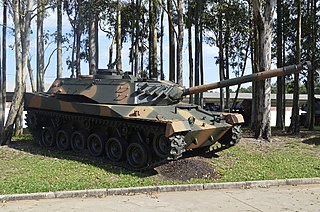Products

- Bernardini X1A1 Light Tank and X1 based XLF missile launcher

- Bernardini MB-3 Tamoyo tank
- Bernardini Xingu BT25 and BT50 (4 x 4) light vehicles (Brazil), Jeep like vehicles based closely on the Toyota Bandeirante
The Bernardini S/A Industria e Comercio (Bernardini Industrial and Commerce Company), of Sao Paulo, Brazil, was a safe manufacturer which operated from 1912 to 1992. During its later years it branched out into vehicle production.



An armoured fighting vehicle or armored fighting vehicle (AFV) is an armed combat vehicle protected by armour, generally combining operational mobility with offensive and defensive capabilities. AFVs can be wheeled or tracked. Examples of AFVs are tanks, armoured cars, assault guns, self-propelled artilleries, infantry fighting vehicles (IFV), and armoured personnel carriers (APC).

A tank destroyer, tank hunter or tank killer is a type of armoured fighting vehicle, predominantly intended for anti-tank duties. They are typically armed with a direct fire artillery gun, also known as a self-propelled anti-tank gun, or missile launcher, also called an anti-tank missile carrier. The vehicles are designed specifically to engage and destroy enemy tanks, often with limited operational capacities.

The T-26 tank was a Soviet light tank used during many conflicts of the Interwar period and in World War II. It was a development of the British Vickers 6-Ton tank and was one of the most successful tank designs of the 1930s until its light armour became vulnerable to newer anti-tank guns. It was produced in greater numbers than any other tank of the period, with more than 11,000 units manufactured giving it the title of the most produced tank during the interwar period. During the 1930s, the USSR developed 53 variants of the T-26, including flame-throwing tanks, combat engineer vehicles, remotely controlled tanks, self-propelled guns, artillery tractors, and armoured carriers. Twenty-three of these were series-produced, others were experimental models.

The M3 Stuart/Light Tank M3, was an American light tank of World War II. An improved version of the tank entered service as the M5 in 1942 to be supplied to British and other Commonwealth forces under lend-lease prior to the entry of the U.S. into the war. Afterwards, it was used by U.S. and Allied forces until the end of the war.

The Renault FT was a French light tank that was among the most revolutionary and influential tank designs in history. The FT was the first production tank to have its armament within a fully rotating turret. The Renault FT's configuration became and remains the standard tank layout. Consequently, some armoured warfare historians have called the Renault FT the world's first modern tank.

The Engesa EE-T1 Osório was a Brazilian main battle tank prototype developed by Engesa. The tank was intended to be sold first to Arab and other Third World countries, jump-starting production — and enabling the Brazilian Army to later place its own orders without having to fund development costs. Development of the tank was initially privately funded by Engesa, but cashflow issues eventually led to the Brazilian government extending a loan to assist the program. Two prototypes of the tank were built, but the EE-T1 was never adopted for service.

Tank classification is a taxonomy of identifying either the intended role or weight class of tanks. The classification by role was used primarily during the developmental stage of the national armoured forces, and referred to the doctrinal and force structure utility of the tanks based on design emphasis. The weight classification is used in the same way truck classification is used, and is intended to accommodate logistic requirements of the tanks.

The M8 light armored car is a 6×6 armored car produced by the Ford Motor Company during World War II. It was used from 1943 by United States and British forces in Europe and the Pacific until the end of the war. The vehicle was widely exported and as of 2006 still remained in service with some countries.

The M41 Walker Bulldog, officially 76-mm Gun Tank, M41, was an American light tank developed for armed reconnaissance purposes. It was produced by Cadillac between 1951 and 1954 and marketed successfully to the United States Army as a replacement for its aging fleet of World War II vintage M24 Chaffee tanks. Although engineered as a reconnaissance vehicle, the M41's weight and armament also made it effective in the close infantry support role and for rapid airborne deployments. Upon entering US service, all M41s received the designation Little Bulldog and subsequently, Walker Bulldog after the late General Walton Walker, who was killed in a Jeep accident in 1950. The M41 was the first postwar American light tank to see worldwide service, and was exported in considerable numbers by the United States, particularly to Asia.

The Centauro is a family of Italian military vehicles originating from a wheeled tank destroyer for light to medium territorial defense and tactical reconnaissance. It was developed by a consortium of manufacturers, the Società Consortile Iveco Fiat - OTO Melara (CIO). Iveco Fiat was tasked with developing the hull and propulsion systems while Oto Melara was responsible for developing the turrets and weapon systems.

The Bernardini MB-3 Tamoyo was a Brazilian main battle tank designed by Bernardini; however, it never reached production status and it never passed beyond the prototype stage (1983). It was followed by the EE-T1 Osório in 1984, the EE-T2 Osório in 1985, and the Tamoyo III in 1987. The tank was armed with a 90mm gun and carried 68 rounds of ammunition.

The L3/35 or Carro Veloce CV-35 was an Italian tankette that saw combat before and during World War II. Although designated a light tank by the Italian Army, its turretless configuration, weight and firepower make it closer to contemporary tankettes. It was the most numerous Italian armoured fighting vehicle and saw service almost everywhere the Italians fought in World War II but proved inadequate for modern warfare, having too thin armour and weak armament of only machine guns. It was cheaply produced but because of its light armaments and armour it was reserved to mostly colonial, policing, reconnaissance, and supply duties. However, given its low production costs, proved to be efficient in the Second Italo-Abyssinian War, Spanish Civil War and the Greco-Italian War where it provided reliable support to Italian infantry and disrupted enemy lines.

The Carro Veloce 33 (CV 33) or L3/33 was a tankette originally built in 1933 and used by the Italian Army before and during World War II. It was based on the imported British Carden Loyd tankette. Many CV 33s were retrofitted to meet the specifications of the CV 35 in 1935. In 1938, the CV 33 was renamed the "L3/33" while the CV 35 became the "L3/35s."

The EE-3 Jararaca is a Brazilian scout car developed for route reconnaissance, liaison, and internal security purposes. It was engineered by Engesa in response to a perceived Brazilian Army requirement for a light armored car capable of replacing its unarmored utility vehicles in the liaison and security role. The first Jararaca prototype appeared in 1979 and serial production commenced in 1982 after extensive operational testing in Brazil. It was ultimately rejected for large scale service with the Brazilian Army due to concerns over the limited mobility of its four-wheeled chassis but achieved some minor successes on the export market.

The fleet of flexible-fuel vehicles in Brazil is the largest in the world. Since their inception in 2003, a total of 30.5 million flex fuel cars and light-duty trucks were registered in the country, and over 6 million flexible-fuel motorcycles, both by March 2018. The market share of flex-fuel autos and light commercial trucks represented 88.6% of all light-duty registrations in 2017. There were over 80 flex car and light truck models available in the market manufactured by 14 major carmakers, and five flex-fuel motorcycles models available as of December 2012.

The Sabrah Light Tank is a light tank or tank destroyer designed by Elbit Systems. Two variants of the Sabrah exist: